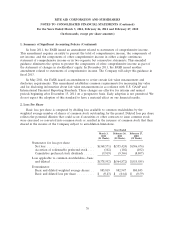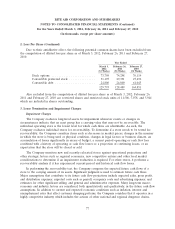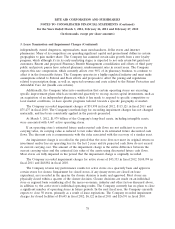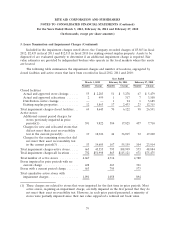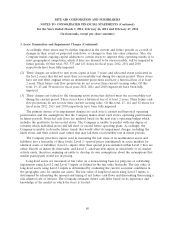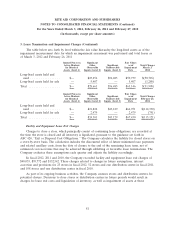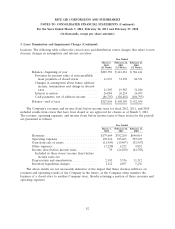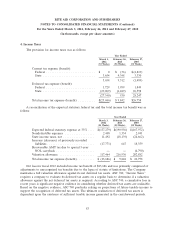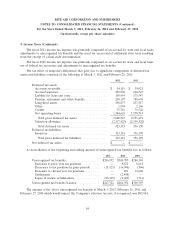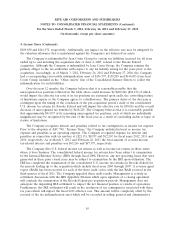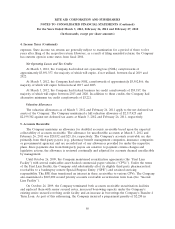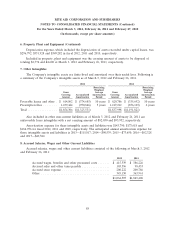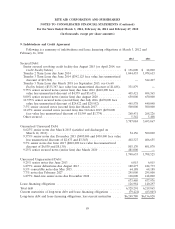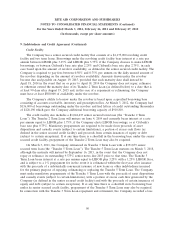Rite Aid 2012 Annual Report Download - page 86
Download and view the complete annual report
Please find page 86 of the 2012 Rite Aid annual report below. You can navigate through the pages in the report by either clicking on the pages listed below, or by using the keyword search tool below to find specific information within the annual report.RITE AID CORPORATION AND SUBSIDIARIES
NOTES TO CONSOLIDATED FINANCIAL STATEMENTS (Continued)
For the Years Ended March 3, 2012, February 26, 2011 and February 27, 2010
(In thousands, except per share amounts)
4. Income Taxes (Continued)
expenses. State income tax returns are generally subject to examination for a period of three to five
years after filing of the respective return. However, as a result of filing amended returns, the Company
has statutes open in some states from fiscal 2004.
Net Operating Losses and Tax Credits
At March 3, 2012, the Company had federal net operating loss (NOL) carryforwards of
approximately $3,891,357, the majority of which will expire, if not utilized, between fiscal 2019 and
2022.
At March 3, 2012, the Company had state NOL carryforwards of approximately $5,502,866, the
majority of which will expire between fiscal 2017 and 2025.
At March 3, 2012, the Company had federal business tax credit carryforwards of $59,187, the
majority of which will expire between 2013 and 2020. In addition to these credits, the Company had
alternative minimum tax credit carryforwards of $3,221.
Valuation Allowances
The valuation allowances as of March 3, 2012 and February 26, 2011 apply to the net deferred tax
assets of the Company. The Company maintained a full valuation allowance of $2,317,425 and
$2,199,302 against net deferred tax assets at March 3, 2012 and February 26, 2011, respectively.
5. Accounts Receivable
The Company maintains an allowance for doubtful accounts receivable based upon the expected
collectability of accounts receivable. The allowance for uncollectible accounts at March 3, 2012 and
February 26, 2011 was $28,832 and $25,116, respectively. The Company’s accounts receivable are due
primarily from third-party payors (e.g., pharmacy benefit management companies, insurance companies
or governmental agencies) and are recorded net of any allowances provided for under the respective
plans. Since payments due from third-party payors are sensitive to payment criteria changes and
legislative actions, the allowance is reviewed continually and adjusted for accounts deemed uncollectible
by management.
Until October 26, 2009, the Company maintained securitization agreements (the ‘‘First Lien
Facility’’) with several multi-seller asset-backed commercial paper vehicles (‘‘CPVs’’). Under the terms
of the First Lien Facility, the Company sold substantially all of its eligible third party pharmaceutical
receivables to a bankruptcy remote Special Purpose Entity (‘‘SPE’’) and retained servicing
responsibility. The SPE then transferred an interest in these receivables to various CPVs. The Company
also maintained a $225,000 second priority accounts receivable securitization term loan (the ‘‘Second
Lien Facility’’).
On October 26, 2009, the Company terminated both accounts receivable securitization facilities
and replaced them with senior secured notes, increased borrowing capacity under the Company’s
existing senior secured revolving credit facility and an increase in borrowings the Company’s Tranche 4
Term Loan. As part of this refinancing, the Company incurred a prepayment penalty of $2,250 in
86


